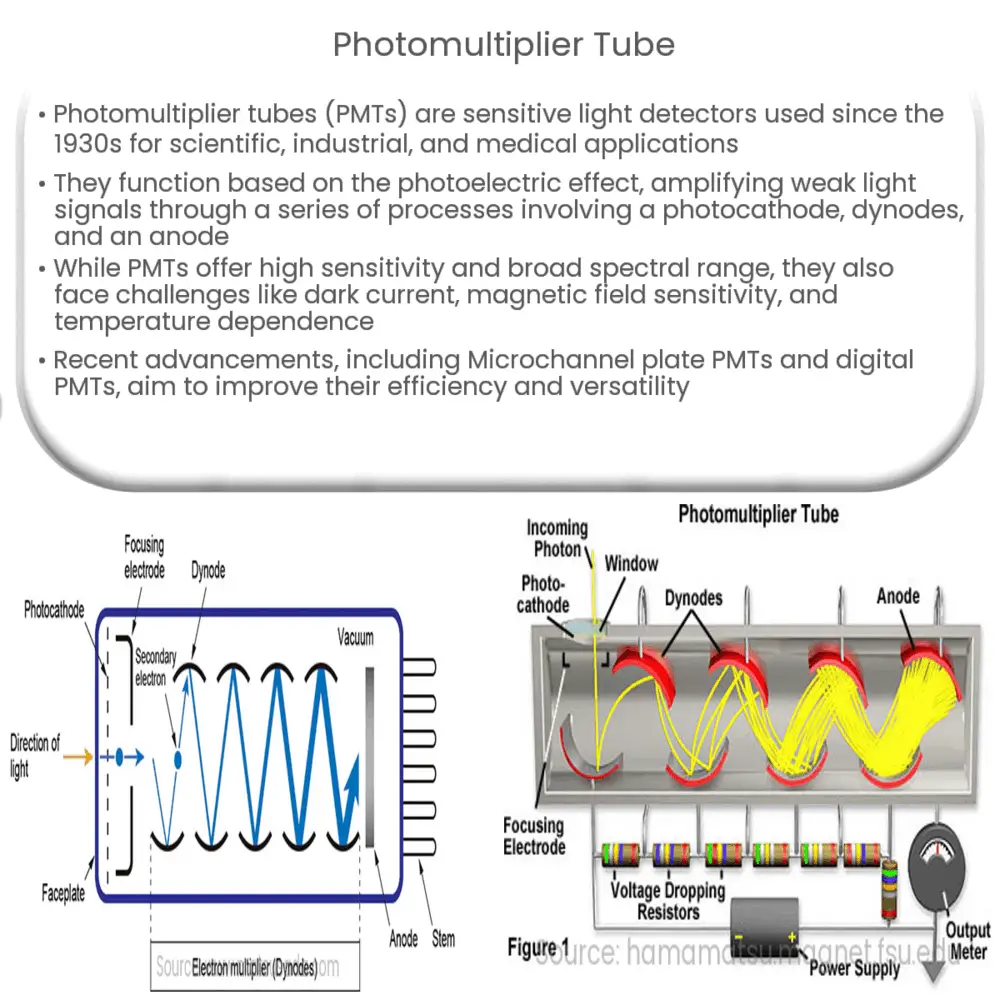Photomultiplier tubes are sensitive light detectors that amplify faint signals, used in scientific research, medical imaging, and environmental monitoring.

Understanding the Photomultiplier Tube: Principles, Applications, and Limitations
Introduction
Photomultiplier tubes (PMTs) are highly sensitive light detectors that have played a crucial role in various scientific and industrial applications since their invention in the 1930s. They are known for their ability to detect and amplify weak light signals, enabling accurate measurements even in low-light conditions. This article aims to provide an overview of the principles behind PMTs, their applications, and limitations, as well as discussing recent advancements in the field.
Principles of Photomultiplier Tubes
Photomultiplier tubes operate based on the photoelectric effect, a phenomenon in which electrons are emitted from a material when it absorbs photons (light particles). A PMT consists of three main components: a photocathode, a series of dynodes, and an anode. The process of signal amplification in a PMT can be divided into three stages:
- Photoemission: When incident light strikes the photocathode, it releases electrons due to the photoelectric effect. The photocathode’s sensitivity to different wavelengths determines the PMT’s spectral response.
- Electron multiplication: The emitted electrons are then accelerated towards the dynodes, which are a series of electrodes maintained at progressively higher voltages. Upon striking a dynode, each electron releases multiple secondary electrons due to the process of secondary emission. This process repeats across multiple dynodes, resulting in a significant amplification of the initial signal.
- Signal collection: The multiplied electrons eventually reach the anode, generating an electrical current proportional to the initial light intensity. This output signal can then be processed and analyzed to determine the properties of the incident light.
The amplification factor of a PMT can reach millions, enabling the detection of extremely low levels of light. However, this high sensitivity comes with some drawbacks, including increased noise levels and susceptibility to external factors such as temperature and magnetic fields.
Applications of Photomultiplier Tubes
Photomultiplier tubes have found widespread use in various fields due to their high sensitivity, fast response times, and broad spectral range. Some of the most common applications include:
- Scientific research: PMTs are extensively used in fields like astronomy, particle physics, and biophotonics for detecting faint light signals or measuring extremely low light levels.
- Medical imaging: PMTs are employed in devices such as scintillation cameras and PET scanners to accurately measure the distribution of radioactive tracers within the body.
- Environmental monitoring: PMTs can be used to analyze water quality, air pollution, and other environmental parameters by detecting trace amounts of luminescent or fluorescent substances.
- Industrial process control: PMTs can be utilized in quality control systems for detecting low levels of light emitted or reflected by materials during manufacturing processes.
Limitations and Challenges of Photomultiplier Tubes
Despite their numerous advantages, PMTs face some limitations and challenges that can impact their performance and suitability for certain applications:
- Dark current: PMTs inherently produce a small amount of current even in the absence of light, known as dark current. This current results from thermionic emission and can cause an increased noise level in the output signal, affecting the accuracy of low-light measurements.
- Magnetic field sensitivity: The presence of external magnetic fields can cause deflection and distortion of the electron trajectories within a PMT, leading to signal degradation. Shielding or compensating techniques are often employed to minimize the effects of magnetic fields.
- Temperature dependence: The performance of PMTs can be affected by temperature variations, with factors such as dark current, gain, and quantum efficiency showing temperature dependence. Careful temperature control or calibration is required to maintain stable PMT performance.
- Size and power consumption: PMTs can be relatively bulky and require high voltages for operation, which may limit their applicability in portable or low-power systems.
Recent Advancements and Future Outlook
In recent years, significant research has been conducted to improve PMT technology and overcome its limitations. Some of the noteworthy advancements include:
- Microchannel plate (MCP) PMTs: These devices incorporate microchannel plates for electron multiplication, resulting in a more compact form factor and lower operating voltages compared to traditional PMTs.
- Super-bialkali photocathodes: The development of super-bialkali photocathodes has led to improved quantum efficiency and spectral response, allowing for better low-light detection capabilities.
- Digital PMTs: Incorporating digital signal processing directly into PMTs enables more accurate and efficient signal acquisition and analysis, as well as improved noise reduction.
As PMT technology continues to evolve, it is expected that these advancements will lead to more compact, efficient, and versatile devices suitable for a wider range of applications. Additionally, the ongoing development of alternative light detection technologies, such as silicon photomultipliers (SiPMs) and avalanche photodiodes (APDs), promises to expand the toolbox of researchers and engineers in need of sensitive light detection and measurement solutions.
Conclusion
Photomultiplier tubes have proven to be invaluable tools in a wide variety of scientific, industrial, and medical applications. Their ability to detect and amplify faint light signals with high sensitivity, fast response times, and a broad spectral range has made them indispensable in many fields. While there are limitations and challenges associated with PMTs, ongoing research and technological advancements continue to push the boundaries of their capabilities and applications. As a result, PMTs will likely remain a crucial component in the detection and analysis of light for years to come.

